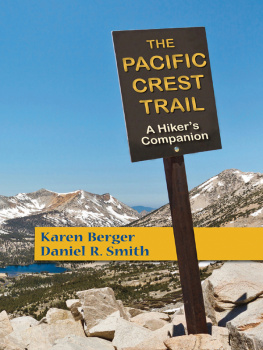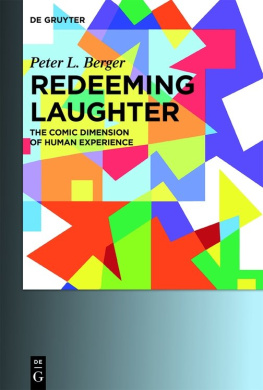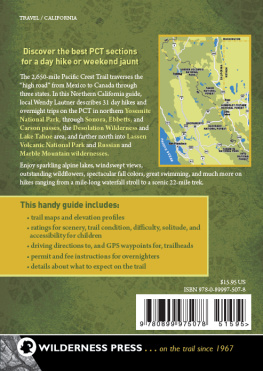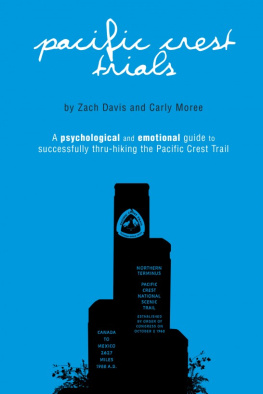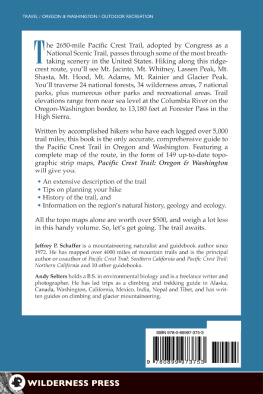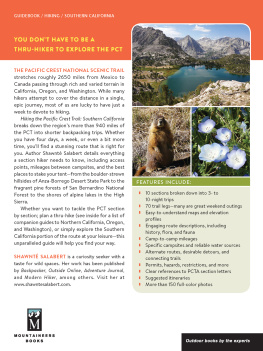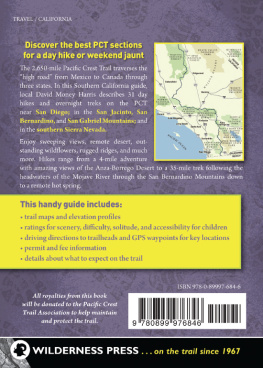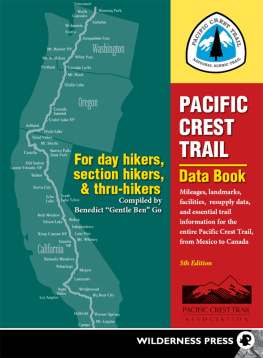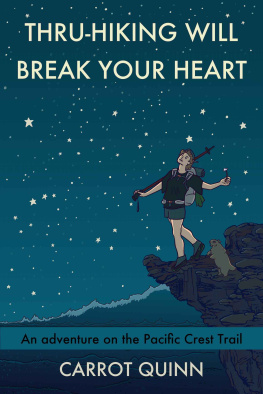
THE
PACIFIC CREST TRAIL
A HIKERS COMPANION
KAREN BERGER & DANIEL R. SMITH

Copyright 2000 by Karen Berger and Daniel R. Smith
Copyright 2014 by Karen Berger
The Pacific Crest Trail
ISBN: 978-1-58157-212-4
ISBN: 978-1-58157-684-9 (e-book)
All rights reserved. No part of this book may be reproduced in any form or by any electronic or mechanical means, including information storage and retrieval systems, without permission in writing from the publisher, except by a reviewer, who may quote brief passages.
The Library of Congress cataloged the previous edition as follows:
Berger, Karen, 1959
The Pacific Crest Trail : a hikers companion / Karen Berger and Daniel R. Smith.
p. cm.
Includes index.
1. HikingPacific Crest TrailGuidebooks. 2. Pacific Crest TrailGuidebooks. I. Smith, Daniel R. (Daniel Richard) II. Title.
GV199.42.P3 B47 2000
917.9dc21
00-031476
Previous Edition ISBN: 978-0-88150-431-6
Maps by Paul Woodward and Steven Hilton, 2000 The Countryman Press
Illustrations by Phyllis Evenden
Interior photographs by Karen Berger and Daniel R. Smith
Interior design by Julie Duquet
Published by The Countryman Press
P.O. Box 748
Woodstock, VT 05091
Distributed by W. W. Norton & Company, Inc.
500 Fifth Avenue
New York, NY 10110
Contents
As a travel writer, I sometimes find that my desire to share my newest travel discovery with readers might not be the best thing for the long-term health of a destination. The fact is that some destinations need more visitorsand some need fewer. Some need more loveand some need less. They say love hurts, and in the case of fragile wildernesses, this is too often true. Too many campfires, too much litter, large noisy groups, food scraps left for animals, springs polluted by pets, forest floors scavenged for firewood.
But sometimes, a place needs a posse of protectors, and nowhere is that more true than long-distance hiking trails. Long-distance trails span multiple jurisdictionsforest service, park service, state, and even private lands. They can remain in deep wilderness for days or skirt populated areas complete with shopping malls. There are competing pressures on these lands: not only recreation but lumbering, grazing, water and wind projects, development. Trails need constituencies, or they will erode to nothing under the ceaseless onslaught of natural and human forces. They need protectors.
In the more than twenty-five years since I first set foot on the Pacific Crest Trail (PCT)and in the sixteen years since I thru-hiked itthe trail has changed. During the many return visits Ive made, Ive seen treadway that has improved in some places and been damaged by fires and floods in others. Todays Pacific Crest Trail Association has grown into a strong, professional operation that lobbies for the trail, protects it, maintains it, publicizes it, and raises funds to support it. With this visibilitywith the funding and maintenance and publicitycomes increased usage. As a result of the pressure of more and more boots, hikers must now have permits to enter many of the most popular wilderness areas. Some parts of the PCT are tightly regulated, with limited permits and strict camping rules.
More long-distance hikers throw themselves against the PCTs 2,700-mile challenge each year. Thru-hikers make up a tiny fraction of PCT users, but they are highly visible, perhaps simply because the dream is just so huge. And with the increasing number of thru-hikers comes the sense of a hiker community, so familiar to the Appalchian Trail. At a big kickoff party near the PCTs southern terminus, down at Lake Moreno in the spring, gear demonstrations and workshops (if thats the right word for sitting in the dirt talking about stuff) present information about lightweight gear and how to get through the High Sierra. More trail angels show up to participate in the long-distance hikers experience, more hiker-friendly hostels offer services, and some of the social customs and vocabulary of the far more crowded and community-oriented Appalachian Trail have found their way west. Im not sure all these things are good, but they are inevitable.
But the PCTIm happy to sayis bigger than all that. Its essential wilderness nature remains, despite the hordes of groups tromping the High Sierra in August, despite the permits and fees. Because heres the thing: Once you head north from the monument at the Mexican border and head up the south-facing slopes of those dry, shadeless mountains with the sun beating down and the convection-oven air sucking all the water out of your pores; once you learn to live with water on your brain because its 20 miles to the next spring and you have no ideayetwhat 20 dry miles feels like; once you descend those endless switchbacks from the top of the San Jacinto Mountains25 miles of twisting turning hairpins that take you from cool mountain pines to low-desert creosote in one shadeless, waterless descent (and then you cross the valley and go right back up again); once you leave the comforting safety of Kennedy Meadows and head into the High Sierra not knowing whether youll be stopped by pass-clogging snow fields or uncrossable snowmelt-filled torrents; once you climb your first Sierra high passes and see the world open up on the other side; once you fight the early-summer mosquitoes in Yosemite; once you hike the long miles of northern California, the volcanic fields of Oregon, the old growth forests of Washingtonthe experience you have will be both uniquely your own and utterly familiar to your brethren in this free-wheeling iconoclastic community. The heat, the lack of water, the cactus, the trail magic, the 30-mile days you didnt know you could do, the 3,000- and 4,000-foot ascents you didnt know you could claim, the endless fields of snow, the endless days of rain: These things, the essence of the PCT experience, dont change, and they cant be tamed.
Indeed, if you are a reader of outdoor narratives, as you hike, you may feel a resonance with those who have gone before and set their experiences to paper or film or, these days, to pixels: Ansel Adams, John Muir, Supreme Court Justice William O. Douglas (all of whom, by the way, have wildernesses on the PCT named after them) wrote descriptions and made images of the trail that are as fresh as the mountain air. And the writers keep coming: There is something about a landscape like this, an endeavor this big, that needs expression. As hikers continue to throw themselves at the monumental challenge of hiking the whole trail, writers continue to throw themselves at the equally monumental challenge of describing what its like to do so.
This book has a less lofty goal. It is not about conquering the trail or any such nonsense, but about attempting to understand it: to explore, to explain, to interpret. The PCT is much more than a very long hiking trail with very big mountains and very grand scenery. It is more than a succession of high passes and pretty lakes and photo ops. It is much more, even, than the dreams of thru-hikers. During its 2,700-mile wanderings, the PCT crosses almost every ecosystem found in the contiguous United Statesall that is missing are the subtropical lowlands of Florida. Hikers tromp past desert flower blooms and arctic tundra, rich old-growth forests and bare volcanic lava beds, creosote deserts, Joshua trees, mountain lions, black bears, poison oak, rattlesnakes, hoary marmots, bald eaglesand thats just the beginning of the beginning of the list. In terms of geology and history, the landscape is just as rich: Hikers step over visible evidence of the San Andreas Fault, skirt the sides of mightiest Cascade volcanoes with their related yet different geological histories, pass the gold rush country of northern California, and cross the paths of settlers and emigrants, including the ill-fated Donner party. At each trail junction, it seems, the trail has a new story to tell. It would be a pity not to see all this because you didnt know it was there.
Next page
